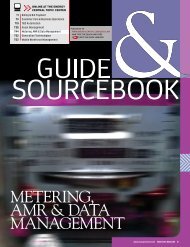Intelligent Utility Jan-Feb 2013
Intelligent Utility Jan-Feb 2013
Intelligent Utility Jan-Feb 2013
Create successful ePaper yourself
Turn your PDF publications into a flip-book with our unique Google optimized e-Paper software.
DISTRIBUTION MANAGEMENT SYSTEMS<br />
Transforming<br />
the electric<br />
utility industry<br />
By Steve Russell<br />
DICTIONARY.COM DEFINES THE INFORMATION<br />
Age as a period “characterized by the gathering and<br />
almost instantaneous transmission of vast amounts of information.”<br />
The development of the distribution management<br />
system (DMS) will enable the electric utility industry to<br />
take advantage of the unprecedented data and technological<br />
advances of the information age resulting in better management<br />
and optimization of distribution grid performance.<br />
Historically, distribution operations have been<br />
characterized by:<br />
? ? The manual operations of devices by field personnel.<br />
? ? Local operation of devices by control panels config-<br />
ured to largely operate independent of one another.<br />
? ? Operational processes based on past practices and a<br />
fixed circuit topology.<br />
? ? Operating parameters based on calculations and<br />
approximations focused on peak loading.<br />
? ? Data spread across multiple databases using various<br />
storage media including computer-based storage as<br />
well as hard copy.<br />
While these approaches have served the electric utility industry<br />
well for over a century, there are inherent limitations<br />
contained in these practices, which DMS enables, that offer<br />
significant benefit to both the customer and utility.<br />
At first glance, the advanced control functions most frequently<br />
discussed in conjunction with DMS would appear<br />
to be its greatest strengths.<br />
The ability to manage and optimize voltage and VAR<br />
flow through volt/VAR control (VVC) and the ability to<br />
automatically locate faults and develop switching solutions<br />
to minimize outage footprints via fault identification and<br />
service restoration (FISR) form the basis for the benefits<br />
made possible by DMS. While both functions generate tremendous<br />
benefit for customers and utilities alike, the real<br />
transformative power of the DMS is contained in the system<br />
model and the continuous, near real-time power flows that<br />
DMS generates.<br />
The heart of a DMS is the data model of the distribution<br />
system. Two types of data are required for the DMS to<br />
accurately represent near real-time conditions for the<br />
system: static and operational.<br />
Static system data is data that describes the distribution<br />
system over an extended time frame. Updates to this data<br />
tend to be long-term in nature and are generally considered<br />
permanent. This data includes information from the GIS for<br />
the distribution connectivity model, system configurations<br />
and land base to represent the distribution lines, as well as<br />
substation internal connectivity to model substation connectivity<br />
and configurations. Additionally, relay settings and<br />
system impedance data are required along with component<br />
and facilities ratings, equipment impedances and ratings,<br />
and device settings from reclosers, capacitors and regulator<br />
control panels. Finally, the DMS could not run near realtime<br />
load flows without customer information regarding<br />
customer count, load data and load schedules.<br />
WWW.INTELLIGENTUTILITY.COM 9















![View From the Trenches [PDF]](https://img.yumpu.com/18854438/1/190x252/view-from-the-trenches-pdf.jpg?quality=85)
